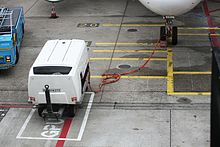Ground power unit
A ground power unit (engl. Ground power unit , GPU) is a ground-based apparatus, the electrical power for aircraft supplies and other flying devices. It supplies alternating current with 115 V and 400 Hz, for smaller aircraft also 28 V direct current . The device can be connected to the power supply of the airport or it can be mounted independently with an internal combustion engine and a generator on a vehicle or trailer.
A special plug contact is connected to the outer socket of the aircraft.
The power supply from the ground power unit enables the auxiliary power unit (APU) on the ground to be switched off and power is still available for electrical devices on board (cockpit, galley, air conditioning, etc.). The switched off auxiliary power unit reduces noise and emissions at the airport , as well as the fuel consumption and the wear and tear of the auxiliary power unit. At airports with modern equipment, the aircraft is supplied with air-conditioned fresh air in addition to electricity from the ground power unit. This Pre-Conditioned Air System (PCA) is an air conditioning system that transfers conditioned air to the aircraft at the passenger boarding bridge.
The ground power device is not sufficient to start the aircraft engines. Only twin-engine business jets are started with an electric starter. The larger fan engines in today's commercial aircraft require compressed air to start the engine. Therefore, shortly before the engine starts, the aircraft's auxiliary engine must be started in order to supply the compressed air required to start the main engines. The ground power device then only supplies the power for starting the auxiliary power unit.
The external power supply for ships in the port is provided by a shore power generator ( cold ironing ; shore power ).
See also
- Auxiliary Power Unit (APU)
- Ground launch device (ASU)
